
Copan Hieroglyphic Stairway
[gbdekgfe]
Other Xoc managed sites:
https://mayacalendar.xoc.net
http://www.mayameetings.org
http://www.xoc.net
http://www.986faq.com
http://grr.xoc.net
http://www.yachtslog.com
A New Reading of the Copán Hieroglyphic Stairway with Implications of the Quiriguá Connection to Smoke Imix God K and 18 Rabbit
by Greg Reddick
During the Long Workshop at the 1996 Maya Meetings in Austin our group, consisting of Ron Dye, Linda Quist, Bill Renner, and the author, having masochistic tendencies, chose to try to decipher part of the Copán Hieroglyphic Stairway. While our group made some progress on deciphering some of the glyphs relevant to this paper, the new information in this paper comes from an insight made by Nicolai Grube followed by a separate insight by Linda Schele while working with our group.
The Copán Hieroglyphic Stairway is a mess. Only the bottom 15 or so stairs were found in their original position; the others having bricks that had fallen out of place. Several glyph blocks appear on a brick and a stair consists of a number of these bricks. At one point in the early 1900s, the bricks were put back on the stairway almost at random. A second attempt has put many of the bricks in some relation to each other. From our examining the drawings, though, it is painfully obvious that much work remains before the bricks are on their original stairs and in the original order. This is made difficult because many of the glyphs are badly eroded.
The stairs are numbered with Stair 1 being the lowest numbered and continuing on up. This paper concerns glyphs that appear on bricks that are currently placed on stairs numbered 6, 7, and 62.
Figure 1: Copán Hieroglyphic Stairway Stair 62 [After Fash]


For days our group struggled just trying to find anything significant to say about the stairway, then Nicolai sat down with us and looked through the our work. On Stair 62 [Figure 1] is a statement of the accession of someone from Quiriguá. Matthew Looper provided recent photos of the casts of Stair 62 from the British Museum that we used to verify the drawings. The glyphs on nearby bricks seem to have little relation to this one, so we couldn't derive a date for when it happened. The glyphs read something like: ch'am k'awil ?-te-ch'a-?-ke to-k(o)-?-Casper Quiriguá Emblem Glyph kan-na. The "ghost-like" figure in C62(b2) I will call "Casper" and from this I will call the person named by these glyphs "Tok-Casper" throughout the rest of this paper, for lack of a better name. This person is closely associated with Quiriguá.
Figure 2: Part of Zoomorph P from Quiriguá [Maudsley, Volume II Plate 63 Image 5]
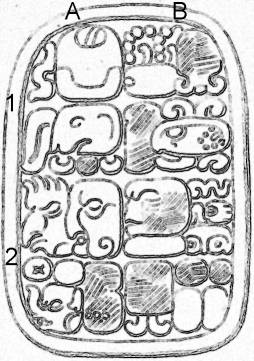
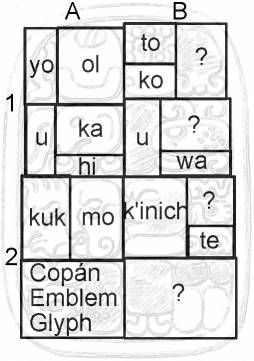
Switch now to Quiriguá. Nicolai remembered a statement of accession to someone also named Tok-Casper on Quiriguá Zoomorph P [Figure 2] in the early reign of Yax-K'uk'-Mo, the founder of the Copán dynasty. The glyph at B1(a2) has been reconstructed by Nicolai as "ko" [Figure 3].
Figure 3: B1(a2) reconstructed to make "ko"

The preceding part of Zoomorph P, records the accession date of Tok-Casper as (8.19.10.11.0) 8 Ahaw 18 Yaxk'in (September 9, 426) [Figure 4]. (All western dates are in this article are in the Gregorian system using the 584285 correlation.)
Figure 4: 8 Ahaw 18 Yaxk'in accession date of Tok-Casper [Maudsley, Volume II Plate 63 Image 6]
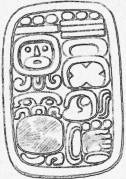
With the information from Stair 62, there is no question that these glyphs from the zoomorph record the accession of Tok-Casper on (8.19.10.11.0) 8 Ahaw 18 Yaxk'in, or September 9, 426 under the authority of Yax-K'uk'-Mo. This date is three days after Yax-K'uk'-Mo founded the Copán dynasty and is a very early date at Quiriguá. From this we derive that Tok-Casper is a founder or other important person from the early years of Quiriguá, but reigned under the authority of Yax-K'uk'-Mo. We also derive that this character is the one mentioned on Stair 62.
Figure 5: Copán Hieroglyphic Stairway Stair 7 [After Fash]
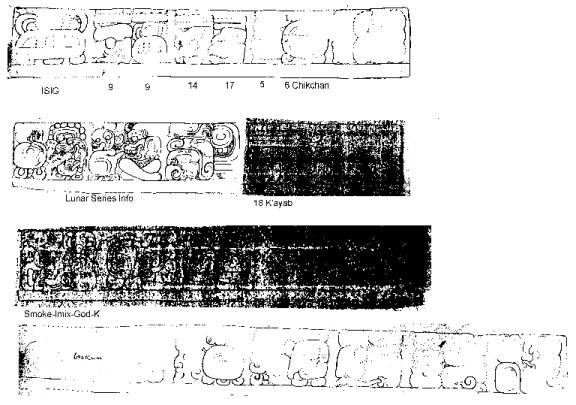
Figure 6: Copán Hieroglyphic Stairway Stair 6 [After Fash]
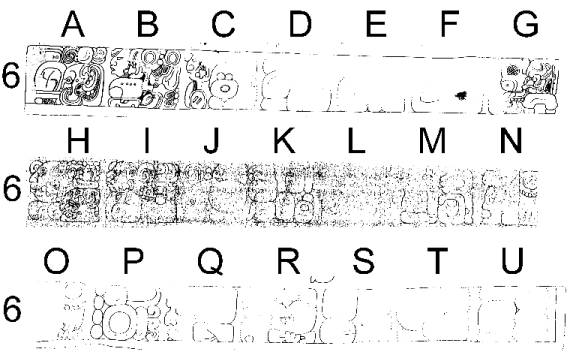
Linda then added her startling piece to the puzzle. Looking at Stairs 6 and 7, which record the accession of Smoke-Imix-God-K, this name seems to show up again. Stair 7 [Figure 5] begins recording the accession of Smoke-Imix-God-K and the statement continues on Stair 6 [Figure 6]. Remember that Stairs 1 through 15 (or so) were found in their original reading order, so long passages like this from these stairs are fairly reliable. Stair 7 begins with an ISIG and long count that can be reconstructed to be 9.9.14.17.5 6 Chikchan 18 K'ayab (February 8, 628). It mentions Smoke-Imix-God-K at glyphblock K7 followed by some unreadable glyphs. Stair 6 continues with a parentage statement for our protagonist. Glyph blocks 6A and 6B introduce the mother's name. This is followed by a very long set of glyph blocks, many of which, unfortunately, are eroded. However, at position H6 and I6 are two very interesting glyph blocks that can be read. Glyphblock H6 has the elements that seem to read "tok," and glyphblock I6 has glyphs for "te ch'a." [Figure 7] These are some of the same name elements that Tok-Casper has on Stair 62.
Figure 7: Glyphblocks H6 and I6 from the Copán Hieroglyphic Stairway.
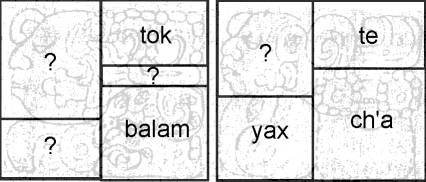
If this reading bears out, it seems that Smoke-Imix-God-K's mother is invoking a founder of Quiriguá as part of her name. This implies that she comes from Quiriguá. This also implies something else: That Smoke-Imix-God-K's son, 18 Rabbit was later probably killed by a cousin, as his paternal grandmother came from Quiriguá. There is one additional interesting thing from Stair 6. Glyphblock K6 begins a parentage statement of Smoke-Imix-God-K's father. Most of the glyphs are unreadable. However, glyphblock R6 is clearly a jaguar head (Balam). This jaguar head does not appear in this form in the name glyphs for any of the previous kings of Copán. It is possible that a name does appear in the eroded portion, but for the sake of argument, let's suppose the Mr. Balam is the father of Smoke-Imix-God-K. Mr. Balam must be someone important to have such a long name, but he is not Butz'-Chan, the previous king. If so, this implies that there was a complete break in the paternal line of accession at Copán: Our protagonist's mother comes from Quiriguá and his father is some unknown lord.
Figure 8: Glyphblock R6 from the Copán Hieroglyphic Stairway [After Fash]

This speculation about the paternal line is further supported by some elementary calculations. Butz'-Chan was born on 9.6.9.4.6 7 Kimi 19 Wo (April 30, 563). He died on 9.9.14.16.9 3 Muluk 2 Kayab (January 23, 628); so he was almost 65 years old when he died. Smoke-Imix-God-K acceded on 9.9.14.17.5 6 Chikchan 18 K'ayab (February 8, 628) and died on 9.13.3.5.7 12 Manik 0 Yaxk'in (June 18, 695); so he was in office for over 67 years. Smoke-Imix-God-K must have been at least a teenager when he acceded. This means that either Butz'-Chan fathered the child who would continue the lineage just before his death, or for some reason he did not have any son who could accede. This provides further argument that Smoke-Imix-God-K's father might be Mr. Balam. This paper demonstrates three important points:
- Tok-Casper was a founder, or other early ruler at Quiriguá under the authority of Yax?K'uk'?Mo.
- There are indications that Smoke-Imix-God-K's mother was from Quiriguá.
- There are indications that Smoke-Imix-God-K's father was not Butz'-Chan, and thus there was a break in the paternal line at Copán.
Point one is a reasonably certain assumption. Points two and three are more speculative, but certainly bear further research.
Bibliography
Fash, Barbara, Drawings of the Copán Hieroglyphic Stairway (unpublished).
Maudsley, A.P., Biologia Centrali-Americana Archaeology.
Top
[www.mayainfo.org] Copyright © 1997-2023 by Gregory Reddick